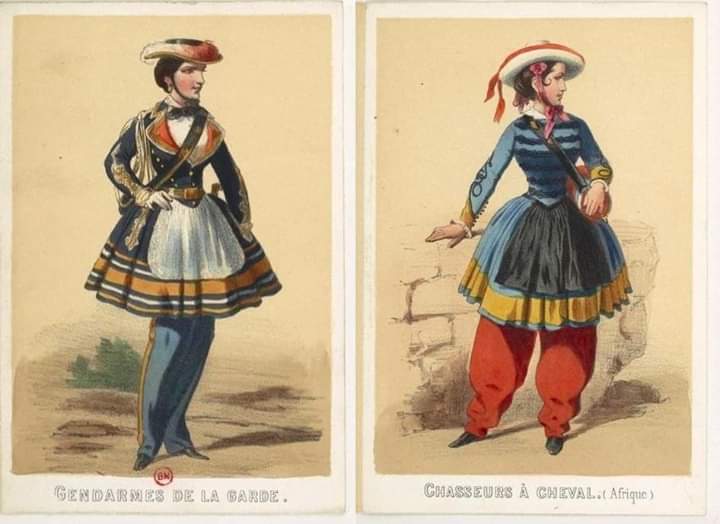Cantiniere
Oggi, dopo aver visto un post, mi sono incuriosita e sono andata a cercare informazioni su questa figura ormai scomparsa dai campi di battaglia....
Con il termine Vivandière o cantiniere venivano indicate le donne che seguivano i reggimento, spesso moglie dei soldati, adibite alla vendita di cibi e bevande.
Le origini dei vivandières sono impossibili da determinare con precisione. Le mogli dei soldati, nell'antichità viaggiavano a seguito degli eserciti tanto che negli anni prima del 1700, gli eserciti avevano spesso più donne e figli che soldati. Fino alla Rivoluzione Francese, il diritto legale di vendere cibo, bevande e articoli da tavola come tabacco, polvere per parrucche, carta da lettere e inchiostro ai soldati di qualsiasi reggimento apparteneva esclusivamente ai pochi soldati detti vivandier. Questo era tipico dell'Europa nel periodo dell'Antico Regime, in quanto usanze e leggi concedevano il monopolio ad un piccolo numero di persone privilegiate.
All'inizio i vivandiers erano soldati spesso troppo occupati con i loro doveri militari per passare il loro tempo a vendere, per questo motivo i loro colonnelli concedevano loro il permesso di sposarsi. Le loro mogli divennero de facto "vivandières" (la versione femminile dei "vivandiers"). Questa operazione di approvvigionamento dell'impresa privata era necessaria perché il sistema logistico forniva raramente alle truppe cibo, bevande o altri oggetti al di là delle razioni di base. Per evitare quindi che i soldati si allintanassero dagli accampamenti, in cerca di questi generi di conforto, e magari disertassero, veniva permesso ai vivandières di integrare le razioni dell'esercito per profitto.
La funzione storica di vendita di vino alle truppe e di lavoro nelle mense portò all'adozione del nome "cantinière", che è venuto a soppiantare l'originale "vivandière" a partire dal 1793, ma l'uso di entrambi i termini è stato comune in francese fino alla metà del XIX secolo, e "vivandière" è rimasto il termine di scelta in paesi non francofoni come gli Stati Uniti, Spagna, Italia e Gran Bretagna.i Vivandières hanno servito nell'esercito francese fino all'inizio della prima guerra mondiale, ma l'usanza (e il nome) si diffuse a molti altri eserciti. Vivandières se ne trovano anche nella guerra civile americana e negli eserciti di Spagna, Italia, Stati tedeschi, Svizzera e vari eserciti in Sud America.

***
Today, after seeing a post, I was curious about this figure who has now disappeared from the battlefields....
Vivandière or cantinière is a French name for women attached to military regiments as sutlers or canteen keepers.
The origins of vivandières are impossible to pin down with precision. Soldiers' wives traveled with armies far back into history, and, in the years before 1700, armies often had more women and children than soldiers.By 1700, there was a clear category of women accompanying the French army, composed of soldiers' legitimate wives who served as vivandières. Until the French Revolution, the legal right to sell food, drink, and sundries like tobacco, wig powder, writing paper and ink to the soldiers in any regiment belonged solely to eight soldiers known as vivandiers. This was typical of Europe in the period of the Old Regime, in that custom and law granted a monopoly to a small number of privileged persons.
At the beginning the vivandiers were soldiers often too busy with their military duties to spend much time selling, their colonels granted them permission to marry. Their wives became de facto 'vivandières' (the female version of 'vivandiers'). This private enterprise provisioning operation was needed because the logistical system seldom supplied the troops with food, drink, or other items beyond basic rations. If the troops could not get these things in camp, they would forage to get them outside, and the army feared that this would lead to desertions. Allowing vivandières to supplement army rations for a profit kept the troops in camp and thus lessened the chance of desertion
Their actual historic function of selling wine to the troops and working in canteens led to the adoption of the name 'cantinière' which came to supplant the original 'vivandière' starting in 1793, but the use of both terms was common in French until the mid-19th century, and 'vivandière' remained the term of choice in non-French-speaking countries such as the US, Spain, Italy, and Great Britain.Vivandières served in the French army up until the beginning of World War I, but the custom (and the name) spread to many other armies. Vivandières also served on both sides in the American Civil War, and in the armies of Spain, Italy, the German states, Switzerland, and various armies in South America, though little is known about the details in most of those cases as historians have not done extensive research on them.